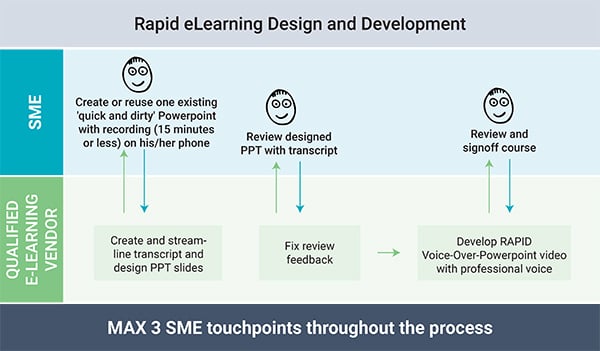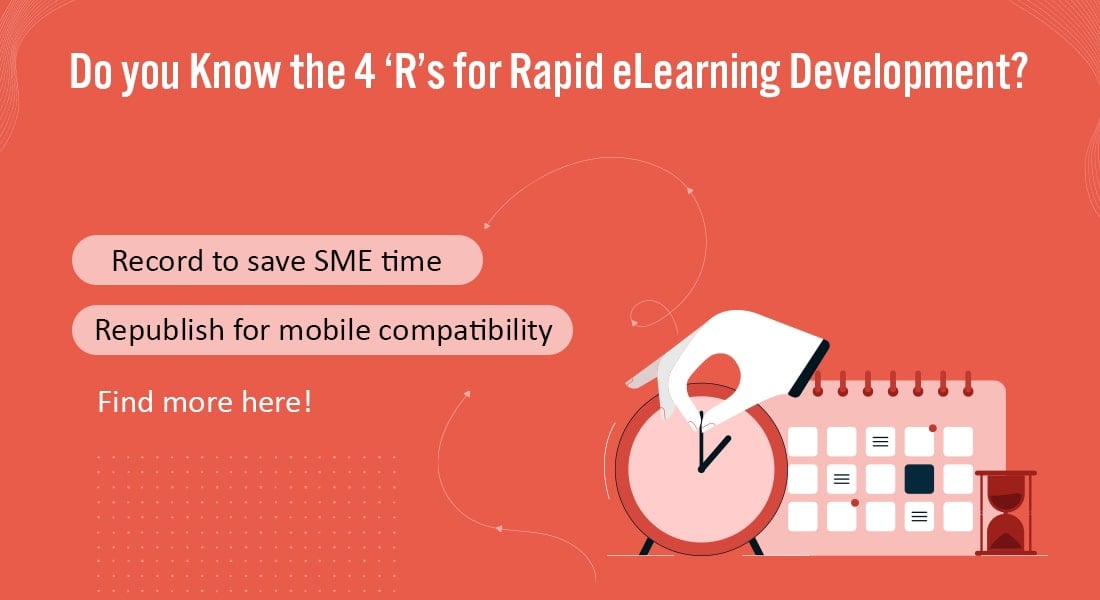The Top 5 Reasons for Rapid eLearning in 2022

Learning and development (L&D) enthusiasts have been hearing a whole lot about rapid eLearning for corporate training. The COVID-19 pandemic has forced us to adopt cost-effective and time-saving training solutions.
According to a study, the global eLearning market is set to reach $457.8 billion by 2026.
Rapid eLearning is ideal for those companies that need to update their training programs regularly to keep up with new rules and developments in the worldwide L&D market. It also helps overcome tight schedules, fast-paced deadlines, and fixed budgets because of its cost-effective nature.
Continue reading to learn why rapid eLearning is so important in today’s world.
Why is Rapid eLearning Essential to Corporate Training in 2022?
Organizations are embracing Rapid eLearning in 2022 because of:
- Rapid Rollout
- New-age Learning That Caters to Millennials
- Multilingual Translation
- Training Disruption
- The Need to Upskill & Reskill
What is Rapid eLearning?
Rapid eLearning is the process of swiftly designing and developing powerful online learning experiences with an emphasis on instructional design principles.
Rapid eLearning helps with a wide range of business training needs, including:
- Transforming classroom material into eLearning, virtual instructor-led training (VILT), microlearning, and blended learning
- Adapting legacy courses for mobile use
- Translating eLearning courses into multiple languages
In the current global pandemic, rapid eLearning has proven to be a boon. eLearning for corporate training has become a necessity to rebuild L&D strategies from the ground up.
The 4 Rs of Rapid eLearning
Rapid eLearning experts design, develop, and publish eLearning courses in weeks rather than months without compromising standards of quality and innovation. This is as opposed to historical eLearning that might take months to develop accelerated online courses. And, in case you’re wondering how that’s even possible, let me introduce you to the 4Rs of rapid eLearning.
The 4Rs – Redesign, Record, Rebuild, and Republish – allow you to transform your traditional classroom training content into engaging and accessible courses, resulting in richer learning experiences. Let’s look at them now.
1. Redesign
As the name suggests, this rapid eLearning strategy allows you to reconstruct your ILT (Instructor-led training) material into online learning formats such as:
- VILT (virtual instructor-led training)
- eLearning courses
- Performance support job-aids
You can choose a format depending on your target audience, the time and content available.
Explore 5 best practices for instructional designers for rapid eLearning design.
2. Record
Record is the strategy of rapid eLearning that reduces the amount of time an SME (subject matter expert) spends on an eLearning project while making sure the Instructional Design team is thoroughly familiar with the training content. In contrast to the traditional eLearning design and development process, that requires SMEs to be involved several times, this strategy provides an easy 5-step process with a maximum of 3 SME touchpoints.

3. Rebuild
You can use the Rebuild technique to break down longer eLearning courses into short, concentrated microlearning nuggets for an engaging learning experience. Microlearning is a highly targeted strategy where each module focuses on a single learning goal. It’s an excellent technique to reinforce what you’ve learned and not forgetting it. Here are a few examples of commonly used microlearning assets.
- Animations
- eBooks
- Games
- Quizzes
- Videos
- Digital flashcards
4. Republish
If you’ve been using eLearning for a while, you’re likely to have several legacy courses in your library that aren’t mobile-friendly. You might have developed them using obsolete software such as Flash or outdated versions of authoring tools. The Republish strategy is a means to revisit legacy courses and give them a new design to increase their utility.
Now that we’ve learned about what rapid eLearning comprises, let’s look at why many firms are embracing this innovative training method in 2022.
Why is Rapid eLearning Essential to Corporate Training in 2022?
1. Rapid Rollout
Corporate training has been significantly affected by the pandemic. There has been significant growth of remote workspaces because of COVID lockdowns. This is in fact beneficial and contributes to the rising workforce. It is necessary to roll out courses quickly as there has been an increase in the demand for online training. This is also because organizations are shifting to hybrid work models, changing modes of operation, and are demanding training for senior management
Rapid eLearning solutions providers have established themselves as market leaders in the corporate training industry because of their ability to address the training needs of a growing workforce and support high standards of quality training. Classroom training with an instructor is no longer a practical option for employees who work from home. Organizations worldwide are now implementing digital training techniques.
Most high-level executives work on tight schedules. Rapid eLearning solutions are developed and rolled out in weeks rather than months, when compared to regular eLearning courses. The faster you train your learners, the faster you get results. The term “rapid eLearning” has now become a buzzword in the L&D space.
Rapid eLearning can save on development time by 40–60 percent when using authoring tools. These devices come with built-in templates for interactivities and games, as well as a library of material for multiple screen layouts and assessments that you can use to design rapid eLearning courses. It’s ideal for employee training courses to be rolled out in no time. It makes little sense to commit extra time and effort on something that you can accomplish in a few weeks, especially when the content has a short shelf life.
Rapid eLearning also minimizes complicated multimedia features in favor of strong instructional design. This results in courses that are short, straightforward, focused, easy to comprehend and recall.
2. New-age Learning that Caters to Millennials
Millennials are a significant contributor to workplace demographics. As a result, it is critical to meet their needs to ensure successful L&D programs.
Millennials are fascinated with training that’s:
Experiential – and provides an experience rather than a presentation.
Comprehensive and quick – Functionality is a given, but courses that are too long and intricate can wear out the present generation, who are looking for quick-fixes and quality solutions. Millennials are keen to stay up to date and like to refer to ready-to-use material. It’s worth noting that most millennials favor mobile-only or mobile-first courses. For the on-the-go generation, mobile learning courses are an absolute lifesaver.
Collaborative – It’s no longer only about learning from the experts.
With Rapid eLearning, you can learn faster. The eLearning design and development process is made easy, and the resulting courses cater to the demands of the current intergenerational workforce. Rapid eLearning makes sure learning is fun and engaging by using instructional design and adult learning principles. It makes room for learners to access training on their mobile devices any time and from any location and embrace modern-day learning methodologies like:
- Microlearning – This strategy is great for onboarding young employees as they are ever on the lookout for quick and easy solutions.
- Rapid eLearning – This technique makes room for eLearning specialists to create digital assets for self-paced eLearning courses and the virtual classroom.
- Gamification is a way to create entertaining courses for the initial training of new millennial and Gen Z workers by adding game mechanics to non-game learning environments.
- Immersive new age learning strategies like AR and VR are a wonderful way to ensure continual learning for the present workforce.
- Social learning approaches training through video conferencing that makes room for live classroom interactions by employees using online discussion forums and chat rooms.
3. Multilingual Translation
Without a doubt, English is a global language. However, many countries and regions speak English as a second language. This implies that many workers respond better when they are allowed to collaborate in their preferred language.
“If you talk to a man in a language he understands, that goes to his head. If you talk to him in his language, that goes to his heart.” – Nelson Mandela
The prevalence of eLearning translation is growing in conjunction with the current global workforce, and it shows no signs of slowing down. The onset of the COVID-19 pandemic has brought about a takeover of remote work models. You need to take into consideration cultural, local norms when translating training material into a variety of global languages. It takes a lot of time and money to train workers around the world. It’s a mammoth task. Businesses are turning to rapid eLearning to fulfil the growing demands of L&D teams and save on resources as well as create easy-to-understand eLearning courses that are making a global impact.
Translating courses into unique, diverse languages is challenging unless done correctly. Rapid eLearning employs CAT (Computer Assisted Translation) technologies vis-a-vis authoring tools. By including multilingual wrappers, global learners can access their courses in the language of their choosing with the click of a button.
When eLearning translation is done well, it showcases organizations’ value for their employees. This also improves worker retention, satisfaction, and confidence, adding up to positive results. Clear and accurate eLearning translation improves organizations’ customer service and quality of production while also effectively training a global workforce.
4. Training Disruption
COVID-19 has created havoc on the business environment, with one of the most affected areas being employee training. Moving your training online ensures the sustainability of business processes and allows L&D managers to avoid training disruption, even when employees work from home. Rapid eLearning can help you overcome training disruption through:
ILT to Virtual Training Changeover
The search rate for virtual training, VILT, and eLearning has increased 80 times because of the COVID-19 crisis. Most organizations that relied in the past on classroom training are now looking for quick ways to make training accessible to employees who are now working from home. Rapid eLearning helps in the quick development of synchronous and asynchronous online training.
Legacy to HTML5 eLearning Conversion
Flash is gone for good. It’s time to save your legacy eLearning courses. Converting your legacy courses using newer versions of authoring tools and transforming courses from flash to HTML5 helps you avoid future disruption to training. Rapid eLearning also expedites and simplifies these conversion processes.
5. The Need to Upskill & Reskill
According to a 2021 Workplace Learning Report, upskilling and reskilling is a top goal for 59% of L&D professionals to guarantee their workers gain skills and perform better on the job.
Since the onset of the COVID 19 pandemic, the requirement for training has grown significantly, particularly in hybrid work structures. Employees must refresh their skills to be competitive in today’s advanced technological environment. You need to update employees on new regulations and procedures implemented because of the pandemic. Upskilling and reskilling are clearly the top priorities of L&D teams throughout the world.
Businesses were put on hold when the globe got hit by COVID-19. As we grappled with the gravity of the situation there was a total and abrupt transformation in the way we connected with one another. Here are a few changes that occurred in industries and workspaces:
- Demand for technology-based and remote services
- Dynamic business scenario
- Emergence of new businesses
- Growing hybrid workforce
Employees that are prepared to meet current organizational needs and adapt to changing situations will help their companies achieve their business objectives. Which means organizations must begin rolling out training at the pace of demand to increase the agility, productivity, and growth of their employees. Rapid eLearning can help as it ensures scalability, speed, and quality to satisfy exponential corporate training needs!
Wrapping it Up!
Rapid eLearning might appear simplistic, but it requires experience in robust instructional design, established channels of communication, authoring tool competency, quality assurance methodology, and accessible resources to make certain quick and easy scale-up of your training programs.
Explore our free eBook on “Rapid eLearning Design for Quick Rollout” to learn more about rapid eLearning. Discover how you can match your training goals and business needs, as well as use powerful online strategies, and best practices when designing Rapid eLearning courses.




![The 4 Rs of Rapid eLearning to End Your Disruptive Training Nightmares [Video]](https://blog.commlabindia.com/hubfs/Imported_Blog_Media/rapid-elearning-4rs-corporate-training-webinar.jpg)
![Want to Upskill and Reskill Your Employees? Try Rapid eLearning [Video]](https://blog.commlabindia.com/hubfs/Imported_Blog_Media/rapid-elearning-upskill-reskill-employees-video.jpg)